Letter Library
Your Letter Library lists the documents you have integrated with your ViewPoint database. Use the Letter Library to create and edit documents, categorize documents, specify who receives this type of document, and indicate the printed output and email requirements for the document.
The ViewPoint 11 (and greater) mail merge feature requires at least Word 2007.
 Open Letter Library- You can open this feature in multiple ways: Use the method that's most convenient for you.
Open Letter Library- You can open this feature in multiple ways: Use the method that's most convenient for you.
ViewPoint Main Menu - Tools & Utilities > Letter Library.
ViewPoint Main Menu - Daily Activities > Print Letters.
ViewPoint toolbar -  Letter.
Letter.
ViewPoint shortcut menu - Forms >  Letter. (Or, press Alt+O on your keyboard to open the Forms options.)
Letter. (Or, press Alt+O on your keyboard to open the Forms options.)
 View / Hide Inactive Documents - Enable or disable the Display inactive documents option at the bottom of the list to toggle whether to include inactive documents in the list. You flag documents as Inactive in the document properties, described below.
View / Hide Inactive Documents - Enable or disable the Display inactive documents option at the bottom of the list to toggle whether to include inactive documents in the list. You flag documents as Inactive in the document properties, described below.
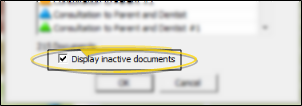
 Document Color-Coding - The Letter Library lists the names of the merge documents you have imported into your system, color-coded green , orange, blue, red, or yellow according to their functionality.
Document Color-Coding - The Letter Library lists the names of the merge documents you have imported into your system, color-coded green , orange, blue, red, or yellow according to their functionality.
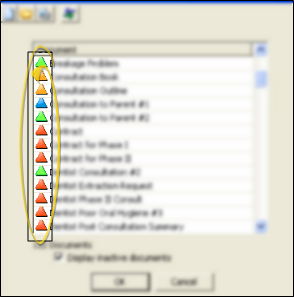
Active / Inactive Documents - Most documents will have either a green icon, indicating they are active and ready to use, or an orange icon, indicating they have been flagged inactive in their Properties window.
Missing Documents - Merge documents in your Letter Library whose document name and/or file path are not found or not accessible to this workstation have either a red icon, indicating they are flagged active in their Properties window, or a blue icon, indicating they are flagged inactive.
Legacy Documents - Merge documents in your Letter Library that have not yet been converted to your ViewPoint 11 database will have a yellow icon. (Use Data Tool (142) - Convert Merge Documents to batch-convert all of your legacy mail merge documents to the ViewPoint 11 database format. If you choose not to run the conversion data tool, each letter will be converted automatically the first time you merge it with ViewPoint. See "Batch-Convert Legacy Letter Library Documents" for details.)
 Edit Documents - (Not available if you opened the letter library from the ViewPoint main menu > Daily Activities > Print Letters option, or if you opened the library with a patient folder active.) Click a document name, then click
Edit Documents - (Not available if you opened the letter library from the ViewPoint main menu > Daily Activities > Print Letters option, or if you opened the library with a patient folder active.) Click a document name, then click  Open in the Letter Library toolbar to go to your word processor, with the document opened and your mail merge integration enabled. Or, if you launched the Letter Library from the Tools & Utilities menu, you can click the Edit button at the bottom of the window, or double-click the document name. If you decide you do not like the changes you made to the document, you can restore your document to a previous version with the Letter History button, described below.)
Open in the Letter Library toolbar to go to your word processor, with the document opened and your mail merge integration enabled. Or, if you launched the Letter Library from the Tools & Utilities menu, you can click the Edit button at the bottom of the window, or double-click the document name. If you decide you do not like the changes you made to the document, you can restore your document to a previous version with the Letter History button, described below.)
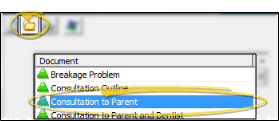
 Create a New Document - Click
Create a New Document - Click  New to go to your word processor with a blank page open, You can edit the text of your mail merge letters, and use mail merge tools to help personalize the documents even further. When you save the document and exit your word processor, you return to theLetter Library where you can define the rest of the document properties.
New to go to your word processor with a blank page open, You can edit the text of your mail merge letters, and use mail merge tools to help personalize the documents even further. When you save the document and exit your word processor, you return to theLetter Library where you can define the rest of the document properties.
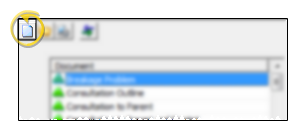
Mail Merge Tools - You can edit the text of your mail merge letters, and use mail merge tools to help personalize the documents even further. When you save the document and exit your word processor, you return to theLetter Library where you can define the rest of the document properties.. See "Mail Merge Tools" for details
 Document Properties - Click a document name, then click
Document Properties - Click a document name, then click  Properties to review or change the document category, select how this document merges with your ViewPoint data, or import new content into this document.
Properties to review or change the document category, select how this document merges with your ViewPoint data, or import new content into this document.
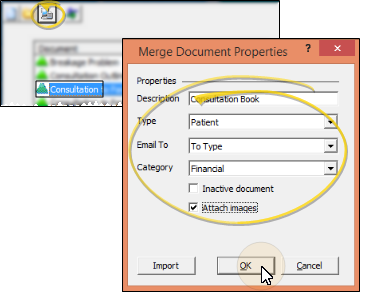
Description - This is the document name that appears in the Letter Library: Each document must have a unique description.
 Type - The Type document property determines the nature of the data to be
merged with your letter. This property works with the Email To property to determine which correspondence history (or histories) will receive a copy of the generated merge document. You may select the document type when you first create a letter, or in the letter properties.
Type - The Type document property determines the nature of the data to be
merged with your letter. This property works with the Email To property to determine which correspondence history (or histories) will receive a copy of the generated merge document. You may select the document type when you first create a letter, or in the letter properties.

 Patient - Select this document type for letters that use biographical and/or treatment data from the patient folder, including letters you send to the patient, responsible party, dentist, referrer, other professional, or insurance company regarding a specific patient.
Patient - Select this document type for letters that use biographical and/or treatment data from the patient folder, including letters you send to the patient, responsible party, dentist, referrer, other professional, or insurance company regarding a specific patient.
If the document includes information about patient contracts, choose the Contract or Responsible Party document type instead.
If you use responsible party variables in a Patient letter, the variables will be filled with the information from the patient's first responsible party only. To be able to specify which responsible party to use, select the Responsible Party document type instead.
Mail merge always saves a copy of Patient letters in the patient's correspondence history. If the Email To property specifies a different party (such as the dentist or other professional), the document will also be recorded in that correspondence history, and the patient's correspondence history will indicate to whom the email was sent.
 Responsible Party - Select this document type for letters that use biographical information or financial totals from a specific responsible party. If you need financial data from a specific contract, select the Contract document type, described below, instead.
Responsible Party - Select this document type for letters that use biographical information or financial totals from a specific responsible party. If you need financial data from a specific contract, select the Contract document type, described below, instead.
Generally, mail merge saves a copy of Responsible Party letters in the patient's correspondence history, indicating the responsible party name. However, if the Email To property specifies a different party (such as the dentist or other professional), the document will be recorded in that correspondence history instead, and not in the patient correspondence history.
 Dentist / Referral / Insurance - Select one of these document types for non-patient letters you send to dentists, referrers, or insurance companies, such as research articles, newsletters, or holiday cards.
Dentist / Referral / Insurance - Select one of these document types for non-patient letters you send to dentists, referrers, or insurance companies, such as research articles, newsletters, or holiday cards.
These document types do not merge any patient-specific data. To send letters that include information about individual patients, select the Patient document type, instead.
Mail merge saves a copy of these letters in the associated party's correspondence history, and not in any patient correspondence history.
 Contract - Select this document type for letters that require financial information specific to an individual contract. If you need financial totals for a billing party, select the Responsible Party document type instead.
Contract - Select this document type for letters that require financial information specific to an individual contract. If you need financial totals for a billing party, select the Responsible Party document type instead.
Generally, mail merge saves a copy of Contract letters in the patient's correspondence history, indicating the responsible party and contract name. However, if the Email To property specifies a different party (such as the dentist or other professional), the document will be recorded in that correspondence history instead, and not in the patient correspondence history.
 Employee - Select this document type for letters that require information about HR Manager records.
Employee - Select this document type for letters that require information about HR Manager records.
Mail merge saves a copy of this type of letter in the associated employee's correspondence history.
If the document includes variables for employee compensation, that information will be omitted from the merged output unless you have full access to your Miscellaneous > HR Manager Compensation security rights. (See "Set Up Security Access" for details.)
Email To - (Not available for all document types.) Use the "email to" property to select the address to use when you send a mail merge document via email. Choose "to type" if you want to use the email address that matches the document type property (for example, if the document type is Patient, and you want to send the document to the patient's email address). In addition if the document type is Patient, Responsible Party, or Contract, and the "email to" property is something else, such as Dentist or Referrer, mail merge will record the generated document in the correspondence histories of both the patient and the party specified in the email to field.
Category - Use the Category document property in your Letter Library to select the history category description to assign to each of your merge documents. When you merge the document for a patient, the correspondence history will include this category.
Inactive / Active Toggle - Once you create a record, you cannot delete it. You can, however, flag it Inactive. Records you flag as Inactive are not available for general use, but they remain in your system for reporting and other data collection needs. In addition, you can toggle records back to Active whenever needed.
Attach Images - Enable the Attach Images option to include any merged patient images as individual attachments to email messages. While images are not included in the body of the email message, they are always embedded in the .PDF file attachment. (If the document does not use any patient images, this option is ignored during the merge.)
Import - To replace an existing merge document with a different document, click the Import button at the bottom of the document's Properties window, then navigate to the document you want to import. Your original document will be overwritten by the newly imported document.
 Import New Document- Use the
Import New Document- Use the  Import icon from the Letter Library toolbar to import an individual Ortho2 merge document, a merge document that another ViewPoint user has shared with your, or a letter that was not created from within the mail merge integration into your Letter Library database.See "Import a Merge Document" for details.
Import icon from the Letter Library toolbar to import an individual Ortho2 merge document, a merge document that another ViewPoint user has shared with your, or a letter that was not created from within the mail merge integration into your Letter Library database.See "Import a Merge Document" for details.
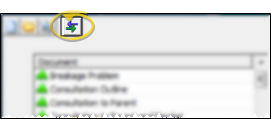
 Letter History - Click the
Letter History - Click the  Letter History icon from the Letter Library toolbar to review a list of revisions made to the selected merge document. You can select a document from the list, and click Preview to see the letter as it was at that point in time, and click Restore to return the document to the selected state.
Letter History icon from the Letter Library toolbar to review a list of revisions made to the selected merge document. You can select a document from the list, and click Preview to see the letter as it was at that point in time, and click Restore to return the document to the selected state.
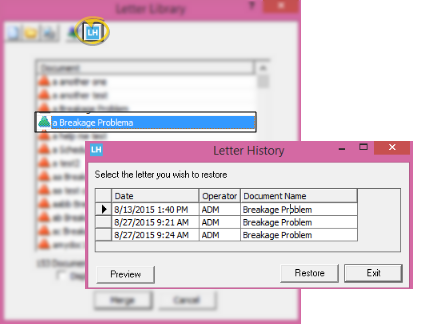
Print - You may want to print this list as a report for reference. See "Document List" for details.
Batch Import Standard Mail Merge Documents - Run Data Tool (101) - Import Merge Documents to import one or more standard Ortho2 merge documents into your Letter Library database.See "Import Standard Mail Merge Documents" for details.
![]() Open Letter Library- You can open this feature in multiple ways: Use the method that's most convenient for you.
Open Letter Library- You can open this feature in multiple ways: Use the method that's most convenient for you.![]() View / Hide Inactive Documents - Enable or disable the Display inactive documents option at the bottom of the list to toggle whether to include inactive documents in the list. You flag documents as Inactive in the document properties, described below.
View / Hide Inactive Documents - Enable or disable the Display inactive documents option at the bottom of the list to toggle whether to include inactive documents in the list. You flag documents as Inactive in the document properties, described below. ![]() Document Color-Coding - The Letter Library lists the names of the merge documents you have imported into your system, color-coded green , orange, blue, red, or yellow according to their functionality.
Document Color-Coding - The Letter Library lists the names of the merge documents you have imported into your system, color-coded green , orange, blue, red, or yellow according to their functionality. ![]() Edit Documents - (Not available if you opened the letter library from the ViewPoint main menu > Daily Activities > Print Letters option, or if you opened the library with a patient folder active.) Click a document name, then click
Edit Documents - (Not available if you opened the letter library from the ViewPoint main menu > Daily Activities > Print Letters option, or if you opened the library with a patient folder active.) Click a document name, then click  Open in the Letter Library toolbar to go to your word processor, with the document opened and your mail merge integration enabled. Or, if you launched the Letter Library from the Tools & Utilities menu, you can click the Edit button at the bottom of the window, or double-click the document name. If you decide you do not like the changes you made to the document, you can restore your document to a previous version with the
Open in the Letter Library toolbar to go to your word processor, with the document opened and your mail merge integration enabled. Or, if you launched the Letter Library from the Tools & Utilities menu, you can click the Edit button at the bottom of the window, or double-click the document name. If you decide you do not like the changes you made to the document, you can restore your document to a previous version with the ![]() Create a New Document - Click
Create a New Document - Click  New to go to your word processor with a blank page open, You can edit the text of your mail merge letters, and use mail merge tools to help personalize the documents even further. When you save the document and exit your word processor, you return to the
New to go to your word processor with a blank page open, You can edit the text of your mail merge letters, and use mail merge tools to help personalize the documents even further. When you save the document and exit your word processor, you return to the![]() Document Properties - Click a document name, then click
Document Properties - Click a document name, then click  Properties to review or change the document category, select how this document merges with your ViewPoint data, or import new content into this document.
Properties to review or change the document category, select how this document merges with your ViewPoint data, or import new content into this document.![]() Import New Document- Use the
Import New Document- Use the  Import icon from the Letter Library toolbar to import an individual Ortho2 merge document, a merge document that another ViewPoint user has shared with your, or a letter that was not created from within the mail merge integration into your Letter Library database.See "Import a Merge Document" for details.
Import icon from the Letter Library toolbar to import an individual Ortho2 merge document, a merge document that another ViewPoint user has shared with your, or a letter that was not created from within the mail merge integration into your Letter Library database.See "Import a Merge Document" for details. ![]() Letter History - Click the
Letter History - Click the  Letter History icon from the Letter Library toolbar to review a list of revisions made to the selected merge document. You can select a document from the list, and click Preview to see the letter as it was at that point in time, and click Restore to return the document to the selected state.
Letter History icon from the Letter Library toolbar to review a list of revisions made to the selected merge document. You can select a document from the list, and click Preview to see the letter as it was at that point in time, and click Restore to return the document to the selected state.

 Letter.
Letter.









